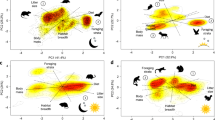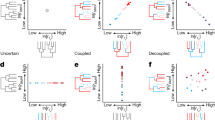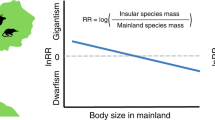Abstract
We propose that mammalian homeothermy was acquired in two steps. The first step enabled mammals to invade a nocturnal niche without an increase in resting metabolic rate. The second step enabled them to invade a diurnal niche and involved the acquisition of higher body temperatures and metabolic rates.
This is a preview of subscription content, access via your institution
Access options
Subscribe to this journal
Receive 51 print issues and online access
$199.00 per year
only $3.90 per issue
Buy this article
- Purchase on Springer Link
- Instant access to full article PDF
Prices may be subject to local taxes which are calculated during checkout
Similar content being viewed by others
References
Huey, R. B. Science 184, 1001–1003 (1974).
Crompton, A. W. & Jenkins, Jr, F. A. in The Evolution of African Mammals (eds Maglio, V. & Cooke) (Harvard University Press, Cambridge, in the press).
Jerrison, H. J. Evolution of the Brain and Intelligence (Academic, New York, 1973).
Jenkins, Jr, F. A. & Parrington, F. R. Phil. Trans. R. Soc., Lond. B 273, 387–431 (1976).
Schmidt-Nielsen, K. Desert Animals. Physiological Problems of Heat and Water (Oxford University Press, New York 1964).
Brett, J. R. in Marine Ecology (ed. Kinne, O.) 1, 513–560 (Wiley-Interscience, London, 1971).
McMahon, T. A. J. appl. Physiol. 39, 619–627 (1975).
Hochachka, P. W. & Somero, G. N. Strategies of Biochemical Adaptation (Saunders, Philadelphia, 1973).
Dawson, T. J. in Comparative Physiology of Thermoregulation (ed. Whittow, G. C.) 3, 1–46 (Academic, New York, 1973).
Bakker, R. T. in Perspectives in Biophysical Ecology (eds Gates, D. & Schmerl, R.) (Springer, Berlin, 1975).
Ricqlès, A. J. Evol. Theory 1, 51–80 (1974).
Lilligraven, J. A. Taxon 11, 261–274 (1974).
Kielan-Jaworowska, A. Nature 226, 97 (1970).
Eisenberg, J. F. & Gould, E. The Tenrecs: A study in Mammalian Behaviour and Evolution (Smithsonian Institution, Washington, DC, 1970).
Dawson, T. J. & Hulbert, A. J. Am. J. Physiol. 218, 1233–1238 (1970).
Kleiber, M. The Fire of Life. An introduction to Animal Energetics (Wiley, New York, 1961).
Hildwein, C. Arch. Sci. Physiol. 24, 55–71 (1970).
Shkolnik, A. & Schmidt-Nielsen, K. Physiol. Zool. 49, 56–64 (1976).
Bakker, R. T. The Physiologist, 15 (1972).
Taylor, C. R. in Scale Effects in Animal Locomotion (ed. Pedley, T. J.) (Academic, London, 1977).
Taylor, C. R., Schmidt-Nielsen, K. & Raab, Am. J. Physiol. 219, 1104–1107 (1970).
Crompton, A. W. & Parker, P. Am. Sci. (in the press).
Author information
Authors and Affiliations
Rights and permissions
About this article
Cite this article
Crompton, A., Taylor, C. & Jagger, J. Evolution of homeothermy in mammals. Nature 272, 333–336 (1978). https://doi.org/10.1038/272333a0
Received:
Accepted:
Published:
Issue Date:
DOI: https://doi.org/10.1038/272333a0
This article is cited by
-
Consistent diel activity patterns of forest mammals among tropical regions
Nature Communications (2022)
-
The decoupled nature of basal metabolic rate and body temperature in endotherm evolution
Nature (2019)
-
The impact of endothermy on the climatic niche evolution and the distribution of vertebrate diversity
Nature Ecology & Evolution (2018)
-
Staying hot to fight the heat-high body temperatures accompany a diurnal endothermic lifestyle in the tropics
Journal of Comparative Physiology B (2018)
-
Invasion of Ancestral Mammals into Dim-light Environments Inferred from Adaptive Evolution of the Phototransduction Genes
Scientific Reports (2017)
Comments
By submitting a comment you agree to abide by our Terms and Community Guidelines. If you find something abusive or that does not comply with our terms or guidelines please flag it as inappropriate.



